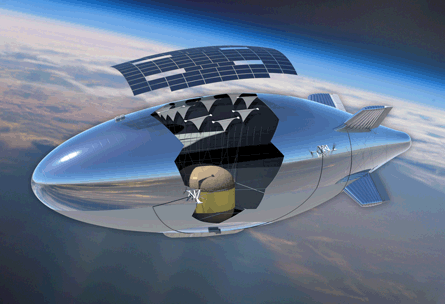About a decade ago the Defense Advanced Research Projects Agency (DARPA) conceived of a new kind of radar antenna.
Though the invention of active electronically-scanned arrays (AESA) had already revolutionised surveillance, by transforming a single radar antenna into hundreds of coordinated transmit and receive (T/R) modules, DARPA wanted to reduce the size of the T/R module even further.
Instead of a roughly 7.62cm- long module, the agency wanted something closer to a microchip, which it named Lightfoot.
A single Lightfoot chip would emit a signal with only one-tenth of the power of a module-sized transmitter-receiver, but it could also be built for a fraction of the cost.
The cheaper, lighter and more flexible material promised jaw-dropping possibilities, such as constructing AESA arrays larger than office buildings.
 |
|---|
© Lockheed MartinLockheed Martin's ISIS airship is to be equipped with a "radar of unprecedented proportions" |
Radar signal strength is a function of power and aperture size. An integrated antenna so large can spot a person walking down the street nearly 200 miles away.
However, most of the publicly-known applications for the Lightfoot radar technology have disappeared, including the ill-fated Space-Based Radar programme.
One surviving programme, however, is perhaps the most ambitious - Lockheed Martin's Integrated Sensor is Structure (ISIS) airship.
In the normally dry budget documents released by the US Department of Defense, the ISIS is described as packing a "radar of unprecedented proportions".
At full scale, the airship's radar will measure 6,000m².
By comparison, the aperture on the Northrop Grumman E-8C joint surveillance target attack radar system (JSTARS), which is still the US Air Force's primary and largest sensor for detecting moving targets on the ground, is less than 5m².
The aperture on ISIS raises the number of T/R components by several orders of magnitude.
Most AESAs measure the amount of T/R modules in hundreds or low thousands, but the ISIS array will be filled with four million such components on microchips.
This ultra-high frequency (UHF) and X-band antenna will be stored inside a stratospheric-roaming airship capable of staying airborne for up to 10 years, without landing to refuel.
Instead, the ISIS carries a bank of solar panels on top to recharge the fuel cells powering the sensor and the vehicle's propulsion system. To keep the airship as light as possible, ISIS also introduces a new composite-laminate fabric with an extremely high strength-to-weight ratio.
Even so, the sensor itself will form 30% of the total mass of the airship.
The system is designed to perform at least three different functions. It should detect moving targets out in the open in the air or on the ground with its X-band antenna, and find stationary targets hidden under camouflage nets or a dense canopy with the radar's UHF frequency.
DARPA launched the ISIS programme in 2005, but the USAF plans to take it over, starting in 2014.
In 2009, an industry team, including Lockheed's airship designers at Skunk Works and Raytheon's radar engineers, beat a Northrop Grumman team for a $400 million contract to design and demonstrate a sub-scale prototype system.
The ISIS demonstrator is now scheduled to make its maiden flight in late 2013, from Lockheed's airship manufacturing base in Akron, Ohio.
The vehicle will be steered overland to the tip of the Florida Keys, where it will remain perched for a flight test period of about three months. Afterward, the vehicle will be at the disposal of US Southern and Northern Commands for a period of about nine months.
It could be used in Southern Command's counter-narcotics operations over the Caribbean, or the border patrols of Northern Command.
The demonstrator should be followed after 2015 with a full-scale operational system, but the USAF has not yet committed funding.
The performance by the demonstrator will likely make the difference, as the USAF begins to consider its budget priorities in the second half of the decade.
Lockheed and DARPA are approaching the demonstration flight carefully.
Although the flight was originally scheduled to begin in 2012, the timeline had slipped by last year, to March 2013.
Earlier this year, however, programme officials decided to delay the maiden flight by another six months.
The delay will allow Lockheed's suppliers to complete bench tests on key radar components before buying materials for production, Lockheed said.
- Click through a DARPA presentation on the ISIS programme, from 2009
Source: Flight International























